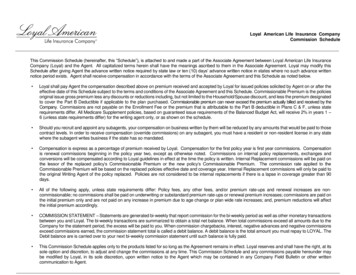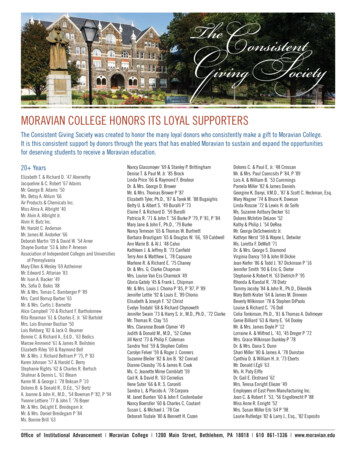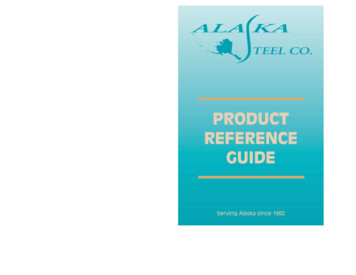
Transcription
o Unmatched Expertise: Industry-leading 500-course curriculum based on first-hand technologyexperience. We have been engaged in ground-breaking projects worldwide for 25 years.o High Client Satisfaction: All of our classes rate good-to-excellent, high client retention, bulk ofour business is from loyal clients or their referrals. See our website for enthusiastic testimonials.o World-class Instructors: Advanced degrees, 15-30 years in the real world, publications, patents,awards, honors. They mix teaching with R&D and consulting to keep their tech edge razor sharp.They are as dynamic and entertaining as they are knowledgeable.o Customized, Practical Courses that focus on your technical needs. Take a class onsite or, insome cases, on the Web. Flexible schedules.o Buy Coach, Travel First Class: Using technology to lower our operating expense, we offer bestin-class instructors and tailored courses for 10-15% below market.Power Your Organization with an Eogogics Workshop! Avoid the cost and delay of trial-and-error.Benefit from our 25 year knowledge of industry best practices and unbiased advice.Join a Distinguished Clientele of Fortune 100/500 CompaniesLockheed Martin, UBS, Boeing, Disney, Raytheon, Dell, AT&T, ABC News, Verizon, Sprint, Comcast,LightSquared, TruePosition, DIRECTV, L-3, ITT, Time Warner, SAIC, URS. Shaw, NIl, Intelsat,Crown Castle, Harris, Booz Allen Hamilton, Spectra Energy, Xerox, Cooper, Bain & Co., DoD, DHS,DoE, DoC, DoJ, GSA, and NASA.Contact us today for free consultation with a subject matter expert!Eogogics Inc www.eogogics.com, www.gogics.com 1 703 281 3525, USA 1 888 364 6442 info@eogogics.com
SDN and NFV: Enhancing Network Capacity and FunctionalitySDN and NFV: Enhancing Network Capacity and FunctionalityWhat’s Motivating the Development of SDN and NFV?Companion article to this web-interactive presentation: https://sway.com/GJpkrBCCDZNroUT5Many new technologies are being developed to address problems in modern day networking. Theseproblems stem from changes in usage patterns (especially growth in mobile computing) anddifficulties in rapidly provisioning services and bandwidth with older technologies such asSONET/SDH. In general, the movement is toward analyzing and operating networks in terms ofcontrol planes and interfaces, with the goal of faster provisioning in a dynamic world, that is, makingnetwork bandwidth available when and where it is needed. This problem is becoming more acute withever-increasing demand for bandwidth and new high-capacity networks ( 400 Gbyte/sec). The majortechnologies in play are: Generalized Multi-protocol Label Switching (GMPLS)Automatically Switched Optical Network (ASON)Ethernet (new high-speed versions)Next generation network (NGN)Optical transport network (OTN)Software Defined Network (SDN)Network Functions Virtualization (NFV)Contact us today for free consultation with a subject matter expert!Eogogics Inc www.eogogics.com, www.gogics.com 1 703 281 3525, USA 1 888 364 6442 info@eogogics.comPage 2
SDN and NFV: Enhancing Network Capacity and FunctionalityThere is much overlap in the solutions that these technologies provide; but all are directed to the goalof better network utilization through faster provisioning. The approximate relationship of these newtechnologies is shown in Figure 1. In this article we shall concentrate on SDN and NFV.Figure 1. Approximate Relationship of New Networking TechnologiesSDN and NFV are technologies designed to tackle related problems in networking and data centeroperation: Proliferation of specialized equipment complicates network and data center Operation andMaintenance (O&M)Difficult to reconfigure wide-area networks or data centers to respond to new or changingneedsSlow to roll out new servicesCostly to throw out old boxes and buy newContact us today for free consultation with a subject matter expert!Eogogics Inc www.eogogics.com, www.gogics.com 1 703 281 3525, USA 1 888 364 6442 info@eogogics.comPage 3
SDN and NFV: Enhancing Network Capacity and FunctionalityVirtualization: Key to Both SDN and NFVThe boundary between SDN and NFV is rather fuzzy, but both utilize the concept of virtualization, andboth employ generic high-performance hardware that can be purchased inexpensively and in largequantities. This hardware is called “white boxes” or “bare metal”.Virtualization.The idea behind virtualization is to make something look like something else to the user by leveragingsoftware. For example, one could make an Apple computer look like a PC to the user—samecommands, displays, and so forth. VMWare is a well-known example of virtualization software,which presents a completely virtualized set of hardware to a guest operating system. That is, anoperating system can be installed on a machine running VMWare, and think it is running natively onhardware including a particular CPU, memory, and video adapter, when in fact all of these are justoffered to the operating system (in effect fooling it) and the actual hardware may be completelydifferent. This approach has a significant advantage, namely that the guest operating system andcomputing environment, including all the user’s programs and data, can be moved to a totallydifferent set of underlying hardware and not skip a beat. So the user would not perceive anydifference, except that programs might execute faster or slower. Note that many such “virtualmachines” can run on a single underlying set of hardware. Virtualization of this sort is enabled by a bitof magic—which may be software, hardware, or firmware—called a Virtual Machine Monitor (VMM),more commonly known as a “hypervisor”. Figure 2 illustrates the general idea:Contact us today for free consultation with a subject matter expert!Eogogics Inc www.eogogics.com, www.gogics.com 1 703 281 3525, USA 1 888 364 6442 info@eogogics.comPage 4
SDN and NFV: Enhancing Network Capacity and FunctionalityFigure 2. Virtualized Computers Using HypervisorWhite Boxes or Bare Metal.These are generic computing and switching elements that utilize components that can bemanufactured inexpensively and in large quantities, such as CPUs and memory. They are designedto operate at extremely high speed and to be configurable under software control. The differencebetween this hardware and standard devices from Cisco and other manufacturers is that these whiteboxes come with an operating system but not the usual (proprietary) control and switchingsoftware/firmware. They usually rely on open source software to configure and operate them.In the context of SDN and NFV, the goal is to make the generic hardware—bare metal or whiteboxes—look like switches, routers, and other network hardware by programming. That is, to virtualizethe functions of these devices. Of course, the devices can be easily reprogrammed and reconfigured,which means that the network and resources that a user sees can be rapidly changed. JohnChambers of Cisco has said, “Cisco's principal competition is to come from ‘white box’ solutions -that is, open source software running on generic server and switch hardware, rather than theproprietary solutions from incumbent providers such as Alcatel-Lucent, Ericsson AB, HuaweiTechnologies Co. Ltd., and Juniper Networks Inc that currently dominate the market.”Contact us today for free consultation with a subject matter expert!Eogogics Inc www.eogogics.com, www.gogics.com 1 703 281 3525, USA 1 888 364 6442 info@eogogics.comPage 5
SDN and NFV: Enhancing Network Capacity and FunctionalitySoftware Defined Networking (SDN)What is SDN?The name “Software Defined Networking” tells the story: software is used to define or create anetwork of resources with some desired set of characteristics. More formally, SDN may be defined asan approach to computer networking that allows network administrators to manage network servicesthrough abstraction of lower-level functionality. This is made possible by virtualization and the whiteboxes. Key elements of SDN are: Network resources are controlled by some sort of dashboard or automatic mechanismLower-level devices (switches, wavelengths, etc.) are reconfigured by software rather thanhardware techsVirtualization is employed through use of software to configure hardware so that it acts likedesired target deviceBenefits of SDN Faster provisioningLower overheadReduced complexitySimplified networkingNote that SDN is an infrastructure technology, used by carriers and ISPs to build better networks, justlike DWDM. It enables better, faster provisioning of services. It is not an end-user service—you can’tbuy SDN, only services enabled by SDN.Flavors of SDN. SDN can be implemented in the Wide Area Network (WAN) or the Data Center.We will consider both.Contact us today for free consultation with a subject matter expert!Eogogics Inc www.eogogics.com, www.gogics.com 1 703 281 3525, USA 1 888 364 6442 info@eogogics.comPage 6
SDN and NFV: Enhancing Network Capacity and FunctionalityWide Area Network SDNWANs or backbone networks have the goal of delivering connectivity to lower level entities such asInternet Service Providers (ISPs). In today’s environment, there is often a need to quickly add orchange service. But networks based on older technology, such as SONET, are not well suited to this,as shown in Figure 3.Figure 3. Wide Area Network ProblemSDN in the WAN seeks to address this by giving network operators the ability to manipulate criticalnetwork parameters under software control. An example of this ability, the “SDN Cockpit”, is shown inFigure 4, which would enable operators to modify modulation schemes, symbol rates, wavelengths,and so forth. We are, however, not there yet. In addition, network vendors need the ability toreconfigure their networks quickly, and this comes from virtualization of switches, routers, and othernetwork devices; but that shades into NFV, which will be covered later.Contact us today for free consultation with a subject matter expert!Eogogics Inc www.eogogics.com, www.gogics.com 1 703 281 3525, USA 1 888 364 6442 info@eogogics.comPage 7
SDN and NFV: Enhancing Network Capacity and FunctionalityFigure 4. Goal of Wide Area SDN: the SDN Cockpit (not yet a reality)Data Center SDNThe Enterprise data center is where SDN is best known, and most advanced in implementation.When SDN is discussed, it is usually in the context of the data center. The common Enterprise datacenter problems that SDN is designed to attack are well known, and include: Existing network infrastructures can respond to changing requirements for management oftraffic flows but process is very time-consumingProtocols designed for unreliable WANs are inefficient for use inside highly reliable datacentersThere is a need to handle rapidly changing resource, QoS, and security requirements ofmobile devicesServer virtualization does not work well with traditional architectures, e.g., with VLANsContact us today for free consultation with a subject matter expert!Eogogics Inc www.eogogics.com, www.gogics.com 1 703 281 3525, USA 1 888 364 6442 info@eogogics.comPage 8
SDN and NFV: Enhancing Network Capacity and FunctionalityPlanes and Their FunctionsThe idea behind SDN in the Enterprise data center is to leverage virtualization and white boxes, aswell as utilizing the distinction between network planes. Network planes are a way of logicallyseparating network functions in order to facilitate network control and configuration. Refer to Figure 5,which shows the three planes commonly used to discuss network functionality.Figure 5. Network PlanesThe function of the planes can be summarized as follows: The Control plane is abstraction of all programs that control a network, including routing,monitoring, route calculation, fault handling, and provisioning.The Data or Transport plane is the hardware that actually does the work, including switching,framing, and low-level error control.The Management plane decides overall network policies, including pricing, services offered,and performance specifications.SDN in the Data Center, North/South-Bound InterfacesThe basic idea of SDN in the data center is quite simple: Each application “sees” a networkconfiguration based on how the network hardware looks to it. This is a “virtual network” in the sensethat the actual hardware constituting the network is not visible to the application, only the pathwaysopen to it, including speeds, reachable locations, and resources such as storage. The Control PlaneContact us today for free consultation with a subject matter expert!Eogogics Inc www.eogogics.com, www.gogics.com 1 703 281 3525, USA 1 888 364 6442 info@eogogics.comPage 9
SDN and NFV: Enhancing Network Capacity and Functionalityknows about each application’s needs. The Control Plane sends signals to the Data Plane toreconfigure switches or other hardware to meet (or better meet) all application needs. This logically(but not physically) reconfigures the network, so that the new network looks like a different physicalnetwork to applications, including networked resources such as storage. That is, no cables arechanged, and no new hardware is installed. Only packet routing, storage, etc. are changed undersoftware control. So with this kind of virtualization, the application “sees” a different network, and theapplication’s data flows through the network now get expedited, or it has access to more storage, forexample. Refer to Figure 6, which shows how the SDN elements sit between applications andunderlying network hardware.Figure 6. SDN Network Configuration. (Source: ADVA Optical Networks)The interface between SDN controllers and applications is called the “Northbound Interface”, and thatbetween the SDN controller and the network hardware is called the “Southbound Interface”.How SDN Operates on FlowsAs indicated above, SDN operates on “flows”. A flow describes a set of packets transferred from onenetwork endpoint to another, which could include TCP/UDP port pairs, VLAN endpoints, or L3 tunnelendpoints. Most networks and data centers have a set of flows that includes most of their workload,Contact us today for free consultation with a subject matter expert!Eogogics Inc www.eogogics.com, www.gogics.com 1 703 281 3525, USA 1 888 364 6442 info@eogogics.comP a g e 10
SDN and NFV: Enhancing Network Capacity and Functionalityso use of flows to control the network or data center configuration makes sense. In the case of SDN,a flow table is put on each packet handling device (SDN controlled device). When a packet comes in,flow table lookup is done to determine action. This is analogous to label switching in MPLS, and isdone at line speed. In this way data is switched through the network. Separately an SDN controllercalculates (and optimizes) flows and flow tables, based on knowledge of network capability andapplication needs, though this is not done at line speed.Figure 7. Operation of SDNOpenFlow and What It DoesOpenFlow is a public domain protocol that is often used as the network management protocol in SDNinstallations. Refer to Figure 7.OpenFlow enables the functionality that SDN is intended to implement. Specifically, OpenFlow: Provides access to forwarding plane of a router or switch over the networkAllows path of data packets within network to be determined by software on at least tworoutersDesigned for network traffic management between switches, routers of different models and vendorsSeparates programming of switches and routers from their hardware Contact us today for free consultation with a subject matter expert!Eogogics Inc www.eogogics.com, www.gogics.com 1 703 281 3525, USA 1 888 364 6442 info@eogogics.comP a g e 11
SDN and NFV: Enhancing Network Capacity and FunctionalityooNo hardware configuration needs to be doneAll control can be flexibly attained through softwareHow OpenFlow WorksOpenFlow works by modifying a switch's packet forwarding tables: adding, modifying and removingpacket matching rules and actions. Routing decisions are made periodically or ad hoc by the SDNcontroller. They are translated into rules and actions with adjustable lifespans, and deployed toswitch’s flow tables. Actual forwarding of matched packets is handled at wire speed by switch forduration of the rules. Unmatched packets (packets for which no flow is assigned) are forwarded to theSDN controller, which must determine what to do with the packets. Figure 8 shows the action of thecontroller and switch.Figure 8. SDN Controller and SwitchFuture of SDNOne scenario is that SDN will expand from data centers to the WAN. In this scenario, RSVP-TE LSPsare dynamically created and deleted at specified times by SDN controller. These LSPs will havebandwidth and source/destinations specified. The SDN controller monitors traffic and utilization ofnetwork in real-time in order to optimize network performance. The SDN controller then controlsContact us today for free consultation with a subject matter expert!Eogogics Inc www.eogogics.com, www.gogics.com 1 703 281 3525, USA 1 888 364 6442 info@eogogics.comP a g e 12
SDN and NFV: Enhancing Network Capacity and FunctionalityMPLS edge routers so that RSVP-TE is signaled accurately at the necessary times. See Figure 9 foran illustration of this scenarioFigure 9. Scenario for Future Expansion of SDN into WANAnother scenario involves a merging of local (data center) and WANs, as resources required forapplication become more scattered. The growth of cloud computing (actually much more thancomputing) also feeds into this model. In this scenario, all network resources are virtualized andcontrollable, as illustrated in Figure 10.Contact us today for free consultation with a subject matter expert!Eogogics Inc www.eogogics.com, www.gogics.com 1 703 281 3525, USA 1 888 364 6442 info@eogogics.comP a g e 13
SDN and NFV: Enhancing Network Capacity and FunctionalityFigure 10. Hypothetical Completely Virtualized SDN EnvironmentNetwork Functions Virtualization (NFV)What Is NFVNFV concentrates more on network functionality. As with SDN, its name is appropriate: NetworkFunctions Virtualization uses virtualization of network components to create functionality. To put itsimply, white boxes or bare metal are used to carry out key network functions such as switching,routing, and firewalls under software control. These virtualized devices can be chained together tocreate communications links and services. In this way, by virtualization of this functionality, a networkcan be reconfigured quickly and new services provisioned rapidly.How NFV Is Related to SDNNFV’s relationship with SDN is shown in Figure 11.Contact us today for free consultation with a subject matter expert!Eogogics Inc www.eogogics.com, www.gogics.com 1 703 281 3525, USA 1 888 364 6442 info@eogogics.comP a g e 14
SDN and NFV: Enhancing Network Capacity and FunctionalityFigure 11. Relationship of SDN and NFVWhat NFV DoesAs noted in the figure, NFV is intended to virtualize entire classes of network node functions intobuilding blocks that may be connected, or chained, to create communication services. Due toadvances in speed and capability of computer hardware, which we see in “white boxes”, any servicenow delivered on proprietary, application specific hardware should be doable on a virtual machine.Essentially: Routers, Firewalls, Load Balancers and other network devices can all run on commodityhardware in virtualized fashion. So NFV principles are: Consolidate many network equipment types onto industry standard high volume servers,switches and storageImplement network functions in softwareCan run on a range of industry standard server hardwareCan be moved to, or instantiated in, various locations in network as required, without need toinstall new equipmentNFV concept based on building blocks of virtualized network functions (VNFs)VNFs combined to create full-scale networking communication servicesContact us today for free consultation with a subject matter expert!Eogogics Inc www.eogogics.com, www.gogics.com 1 703 281 3525, USA 1 888 364 6442 info@eogogics.comP a g e 15
SDN and NFV: Enhancing Network Capacity and Functionality VNFs handle specific network functions that run in one or more virtual machines on top ofhardware networking infrastructureNFV Advantages Virtualization: Use network device without worrying about where it is or how it is constructed Orchestration: Manage thousands of devices efficientlyProgrammable: Change behavior on the flyDynamic scaling: Change size, quantityPerformance: Optimize network device utilizationOpenness: Full choice of modular plug-ins See Figure 12 for a view of NFV as virtualized network appliances.Figure 12. Virtualization in NFV (Source: Steve Noble)Contact us today for free consultation with a subject matter expert!Eogogics Inc www.eogogics.com, www.gogics.com 1 703 281 3525, USA 1 888 364 6442 info@eogogics.comP a g e 16
SDN and NFV: Enhancing Network Capacity and FunctionalityService Function Chaining.Service function chaining is how virtualized network services are assembled into a desired networkservice. First define an ordered list of a network services (e.g. firewalls, NAT, QoS) needed by acustomer or group of customers. These services are called “Virtual Network Functions” (VNFs). Theyare "stitched" together in a network to create a service chain, i.e., a path through which packets with acertain tag flow. The VNFs themselves are created through virtualization, with a virtualizationsoftware layer on top of underlying physical hardware, and through use of white boxes. This isillustrated in Figure 13.Figure 13. Chaining in NFVNFV Reference ArchitectureThe European Telecommunications Standards Institute (ETSI) has done much of the developmentwork on NFV. Their “reference architecture” illustrates the basic components of an NFV installation. Itshows the Operational Support System/Business Support System (OSS/BSS), which utilizes theContact us today for free consultation with a subject matter expert!Eogogics Inc www.eogogics.com, www.gogics.com 1 703 281 3525, USA 1 888 364 6442 info@eogogics.comP a g e 17
SDN and NFV: Enhancing Network Capacity and Functionalityvirtualized functionality, the virtual network functions, and the virtualization layer that turns physicalhardware into virtual functions such as computing, storage, and network connectivity. TheManagement and Orchestration component, known as “MANO”, is what controls the virtualization andthus the functionality seen by users. The reference architecture is shown in Figure 14. Note thatpractical implementations do not always separate the functions shown in the MANO.Figure 14. NFV Reference Architecture from ETSINFV ExampleConsider the case of an Enterprise service consisting of managed router and managed VPN, asshown in Figure 15. If additional service are needed, the Service Provider dispatches a technician onsite to install, configure, and test the new device(s) needed, e.g., new firewall.Contact us today for free consultation with a subject matter expert!Eogogics Inc www.eogogics.com, www.gogics.com 1 703 281 3525, USA 1 888 364 6442 info@eogogics.comP a g e 18
SDN and NFV: Enhancing Network Capacity and FunctionalityFigure 15. Old Way of Changing ServiceWith NFV, matters are much simpler and faster. The IT manager logs onto a self-service portal andorders the additional managed firewall service. The NFV software takes it from there: portal sends aservice order to the NFV system, which installs firewall virtual function on an available virtual machinein the central office or PoP. It reconfigures metro aggregation switch to steer appropriate packet flowsto virtual function, and updates billing record in back office billing system, as shown in Figure 16.Figure 16. Example with NFVContact us today for free consultation with a subject matter expert!Eogogics Inc www.eogogics.com, www.gogics.com 1 703 281 3525, USA 1 888 364 6442 info@eogogics.comP a g e 19
SDN and NFV: Enhancing Network Capacity and FunctionalityMore on Relationship between SDN and NFVSDN comes out of large-scale IP infrastructures. It is intended to establish and exercise centralcontrol over packet forwarding, simplify traffic management, and achieve operational efficiencies,primarily in a large (Enterprise-scale) data center. It utilizes an open networking environment andelements such as switches, servers and storage configured and managed centrally. These elementsrun on standard hardware components (“white boxes”). There is separation of network control logicfrom physical routers and switches that forward traffic.NFV Originated from SDN. It was developed for service providers interested in facilitating deploymentof new network services. NFV virtualizes networking devices and appliances. The goal is to avoidproliferation of physical devices to fill specialized roles such as routing, switching, content filter, spamfiltering, and load balancing. The virtual implementations provide important network functions insteadof specialized physical devices. The goal is to achieve WAN acceleration and optimization, reducedevelopment/deployment costs and risks, and handle unified threat management.The current relationship between SDN and NFV is summarized in Figure 17. In the future, asdiscussed earlier, the functionality of these two will likely merge. In fact that trend is well underwaywith large-scale providers such as Google and Amazon.Figure 17. Current Relationship of SDN and NFV (Source: Overture Networks)Contact us today for free consultation with a subject matter expert!Eogogics Inc www.eogogics.com, www.gogics.com 1 703 281 3525, USA 1 888 364 6442 info@eogogics.comP a g e 20
SDN and NFV: Enhancing Network Capacity and FunctionalitySummarySDN and NFV have been developed to help meet the challenge of increasing demand for servicesand user expectation of rapid provisioning and universal availability. Both rely on virtualization, theability to make a piece of equipment look like another via the magic of software. What makes thiscost-effective is the availability of inexpensive but powerful computing units that can easily beprogrammed to take on many different functions such as switches, firewalls, and routers.SDN was originally developed to address the problems of large data centers, where virtualization ofhardware and operating system is important (think cloud computing). It will likely spread to otherareas, including the WAN, where virtualization and the ability to dial up bandwidth and relatedcharacteristics would be extremely valuable as well. NFV is an outgrowth of SDN in many respects,concentrating on backbone networks, where the need to rapidly reconfigure resources is key.Both SDN and NFV are conceptualized in terms of planes, i.e., the control plane or thehardware/software that configures and controls a network, the data plane that does the actual work,and the management plane that sets network policies such as services offered, performance specs,and pricing. The control plane looks to optimize network flows, and creates new ones when needed. Itcan also define new services using existing resources or by reprogramming hardware.SDN and NFV are here to stay and grow and may ultimately merge into a unified means of creating,controlling , and allocating network resources from the LAN to the WAN.Editor's Note: Eogogics offers courses on SDN, NFV, and CloudComputing d-computing-courses/) and related IP Networkingtopics -mpls-courses/). We also offer market intelligenceresearch (https://www.eogogics.com/store/) on SDN, NFV, and related areas.N LTDnrContact us today for free consultation with a subject matter expert!Eogogics Inc www.eogogics.com, www.gogics.com 1 703 281 3525, USA 1 888 364 6442 info@eogogics.comP a g e 21
SDN and NFV: Enhancing Network Capacity and Functionality Figure 4. Goal of Wide Area SDN: the SDN Cockpit (not yet a reality) Data Center SDN The Enterprise data center is where SDN is best known, and most advanced in implementation. When SDN is discussed, it is usually in the context of the data center. The common Enterprise data










